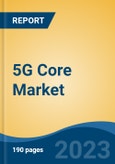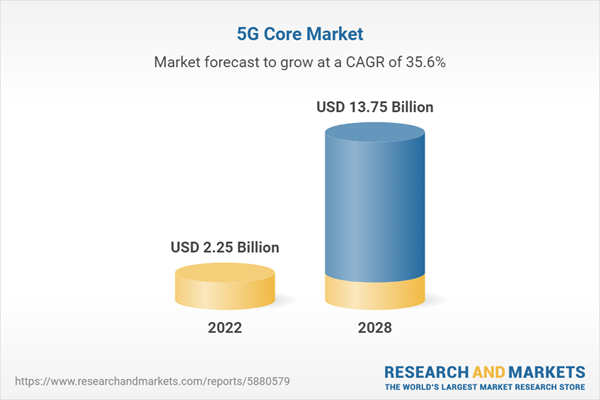Speak directly to the analyst to clarify any post sales queries you may have.
10% Free customizationThis report comes with 10% free customization, enabling you to add data that meets your specific business needs.
The 5G Core is the core of 5G mobile network (5GC). It establishes a connection between end users and the network and grants them dependable and secure access to its services. Numerous mobile network functions, including connectivity and mobility management, authentication and authorization, subscriber data management, and policy management are handled by the core domain. Regardless of the underlying cloud architecture, 5G Core network services are totally software-based and cloud-native, offering better deployment agility and flexibility. Industry experts outlined how the core network should change to accommodate 5G New Radio's (NR) requirements as well as the additional use cases that 5G would make possible. They worked together to develop the 3GPP 5G Core standard for core networks (5GC).
Increasing Necessity of Cloud-Native & Service-Based Framework
The need for low-cost data storage, backup, and data protection is one of the driving forces propelling small and medium-sized organisations (SMEs). Businesses may provide better IoT services to various industrial verticals by using the cloud. The connected supply chain and intelligent manufacturing techniques heavily rely on connected and smart products. The creation of reasonably priced connected devices has also enabled manufacturers to leverage IoT technology to cut down on resource usage and increase overall productivity. IoT applications also have a low operational cost, which encourages many firms to include them into their gear in order to boost productivity and cut costs. The 5G Core offers technologies that were previously not available in mobile core networks, such as a service-based architecture (SBA), cloud-native network functions built on containers and based on microservices as well as cloud infrastructure, which collectively represent a significant technological shift. These new technologies will alter how businesses construct, manage, operate, and monetize this new core network. In order to create a 5G core market, it is essential to totally re-engineer the network and organisation from end to end, aiming for high levels of automation and agility when delivering new innovative services.Construction Of Smart Infrastructure to Fuel the Market Demand
The rate at which 5G is implemented across the world will decide how quickly it becomes a crucial technology of smart cities. Today, cities are home to about 55% of the world's population. By 2050, the United Nations projects that this percentage will have been increased to 68%. By the same year, the population of the world's main cities will have increased by 2.5 billion due to the continued movement of people from rural to urban regions and overall population growth. In order for smart city projects to be implemented successfully, telecommunications infrastructure and its application for public safety are essential. In order for smart city projects to be implemented successfully, telecommunications infrastructure and its application for public safety are essential. Every city needs to make sure that communication channels are developed and available if it wants to realise the concept of smart cities in an open and resource-efficient way. The fundamental tenet of smart cities is that resource and operations management in so many large cities can only be economical and successful if it is automated and networked for instance driverless vehicles, remote healthcare, traffic safety management, and electric grid management. All these factors are helping in boosting the growth in the 5G core market.Advancements in Network Infrastructure
The new 5th generation specification, known as the 5G core network framework, serves the growing demand for high connection speed performance in both developed and developing countries. The MEC framework, which is key to the 5G architectural ideas, can be used to create the software functions of virtual servers, which are another focus of the 5G core. During 2024 and 2028, the adoption of IoT applications and escalating technological advancements in machine-to-machine communication networks are projected to open up new prospects for the worldwide 5G core network market. Additionally, between 2024 and 2028, the telecommunications industry's adoption of virtual networking architecture will increase along with the expanding demand for private 5G connections among businesses, industrial sectors, and the government.Market Segmentation
The 5G Core market is segmented into component, deployment mode, end user, networking functions and region. By component, it is divided into solution, service. The deployment mode area segment is further categorized into cloud and on premise. Depending on end user, the market is fragmented into consumer amd enterprise. Based on networking functions, market is segmented into AMF (Access and Mobility Management Function), SMF (Session Management Function), UPF (User Plane Function), PCF (Policy Control Function), NEF (Network Exposure Function), NRF (NF Repository Function), UDM (Unified Data Management), AUSF (Authentication Server Function), AF (Application Function), NSSF (Network Slice Selection Function) and others.Market Player
Major market players in the global 5G core market are Affirmed Networks, Inc., NEC Corporation, Cisco Systems Inc., Samsung Electronics Co. Ltd., Hewlett Packard Enterprise Development LP, Nokia Corporation, Oracle Corporation , Telefonaktiebolaget LM Ericsson, Huawei Technologies Co. Ltd., ZTE Corporation.Report Scope:
In this report, the Global 5G Core market has been segmented into the following categories, in addition to the industry trends which have also been detailed below:5G Core Market, By Component:
- Solution
- Services
5G Core Market, By Deployment Mode:
- Cloud
- On Premise
5G Core Market, By End User:
- Consumer
- Enterprises
5G Core Market, By Network Functions:
- AMF (Access and Mobility Management Function)
- SMF (Session Management Function)
- UPF (User Plane Function)
- PCF (Policy Control Function)
- NEF (Network Exposure Function)
- NRF (NF Repository Function)
- UDM (Unified Data Management)
- AUSF (Authentication Server Function)
- AF (Application Function)
- NSSF (Network Slice Selection Function)
- Others
5G Core Market, By Region:
- North America
- United States
- Canada
- Mexico
- Asia-Pacific
- India
- Japan
- South Korea
- Australia
- Singapore
- Malaysia
- Europe
- Germany
- United Kingdom
- France
- Russia
- Spain
- Belgium
- Italy
- South America
- Brazil
- Argentina
- Colombia
- Peru
- Chile
- Middle East
- Saudi Arabia
- South Africa
- UAE
- Israel
- Turkey
Competitive Landscape
Company Profiles: Detailed analysis of the major companies present in the Global 5G Core market.Available Customizations:
Global 5G Core market report with the given market data, the publisher offers customizations according to a company's specific needs.This product will be delivered within 1-3 business days.
Table of Contents
Companies Mentioned
- Affirmed Networks, Inc.
- NEC Corporation
- Cisco Systems Inc.
- Samsung Electronics Co. Ltd.
- Hewlett Packard Enterprise Development LP
- Nokia Corporation
- Oracle Corporation
- Telefonaktiebolaget LM Ericsson
- Huawei Technologies Co. Ltd
- ZTE Corporation
Table Information
| Report Attribute | Details |
|---|---|
| No. of Pages | 190 |
| Published | September 2023 |
| Forecast Period | 2022 - 2028 |
| Estimated Market Value ( USD | $ 2.25 Billion |
| Forecasted Market Value ( USD | $ 13.75 Billion |
| Compound Annual Growth Rate | 35.6% |
| Regions Covered | Global |
| No. of Companies Mentioned | 10 |









